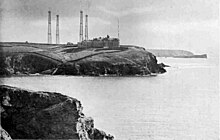Poldhu
Poldhu is a small area in south Cornwall, England, UK, situated on the Lizard Peninsula; it comprises Poldhu Point and Poldhu Cove. Poldhu means "black pool" in Cornish. Poldhu lies on the coast of Mount's Bay and is in the northern part of the parish of Mullion; the churchtown is 2 kilometres (1.2 mi) to the south-east. On the north side of Poldhu Cove is the parish of Gunwalloe and the village of Porthleven is a further 7 kilometres (4.3 mi) to the north.[1]
Poldhu Point became the site of one of the main technological advances of the early twentieth century when, on 12 December 1901, a
The beach at Poldhu was heavily mined during World War II to prevent any prospect of a German force landing there. As an unfortunate result, on 24 April 1943, Royal Air Force Volunteer Reserve members Mair Myfannwy Richards and Reginald Thomas Smith both died instantly when Mair trod on an unmarked mine.[3]
In January 2016 Poldhu Cove was inundated with thousands of pink plastic bottles, brought onto the beach with successive tides. The National Trust, which organised the clean-up, thought they had likely come from a container ship, and had been washed overboard in recent storms.[4]
Marconi's Poldhu Wireless Station

The site is famous as the location of Poldhu Wireless Station,
To design the spark transmitter, the first high power radio transmitter in the world, Marconi hired Prof. John Ambrose Fleming, University College, London.[6] The original twenty mast circular aerial was destroyed in a storm on 17 September 1901.[6][7][8] Marconi hastily built a temporary aerial of 50 wires suspended in a fan shape from a cable between two 200 foot (61 m) masts.[9] Fleming estimated the transmitter's radiated power was around 10–12 kW.[10] The frequency used is not known precisely, as Marconi did not measure wavelength or frequency, but it was between 166 and 984 kHz, probably around 500 kHz.[6] After the experiment the original mast layout was not rebuilt, it was replaced with a four mast design, 215 feet (66 m) high and forming a 200-foot (61 m) square.

Marconi later used the site for his
The station closed in 1934 and was demolished in 1937.
The substantial building near the site, originally the Poldhu Hotel, built in 1899, is currently a care home. The visitors' book shows that Marconi stayed there in May and August 1901.[2]
Marconi also built an earlier, smaller, experimental wireless station nearby at Housel Bay – The Lizard Wireless Station.
In popular culture
Sherlock Holmes and Dr. Watson are staying "together in a small cottage near Poldhu Bay" in "The Adventure of the Devil's Foot", a 1910 short story by Arthur Conan Doyle.[11]
In the first episode of the 2018 female-led adaptation
References
- ISBN 9-7803-19-241172.
- ^ ISSN 0070-024X.
- ^ "Defence of Britain Archive".
- ^ "Thousands of pink bottles wash up on Cornwall's beaches". BBC News. 5 January 2016.
- ^ "Construction of Poldhu Station begins". Marconi Collection. Retrieved 10 December 2014.
- ^ a b c
ISBN 0471783013.
- ^ "Aerial before storm, Poldhu". Marconi Collection. Retrieved 10 December 2014.
- ^ "Poldhu after the storm". Marconi Collection. Retrieved 10 December 2014.
- ^ "Marconi section". Broadcast Archive. Retrieved 4 April 2010.
- ^ Fleming, John Archibald (1906). The Principles of Electric Wave Telegraphy. London: Longmans Green and Co. pp. 449–454.
- ^ Doyle, Arthur Conan (1968). The Annotated Sherlock Holmes Volume II. London: John Murray. p. 508.

